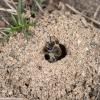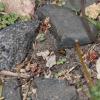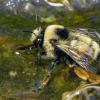With Pollinator Week upon us, now is the time to reaffirm our commitment to protecting these vital invertebrates. Here are some tangible ways to help.
It’s an exciting time: Pollinator Week is upon us! If, like me, you’ve been involved with pollinator conservation for a long time, you’ll remember when people looked at you as if you were crazy when you stood up and said, “Hey, what about bees?” It was very much out there on the “weird wing” of conservation. (The term “bee guy” wasn’t always applied with enthusiasm: “look out, here comes the bee guy.”) But now there is a whole week dedicated to recognizing the unseen heroes of our world—bees, flies, butterflies, beetles, and other insects—and people gather in crowds to celebrate them. It’s very cool.
If you want to join one of those gatherings to learn more about bees, butterflies, and other pollinators and find out what you can do to support them, there are many events around the country this week—whether organized by Xerces, Bee City USA affiliates, or other organizations. You’ll find details of events that we’re involved with on our events page. There are over 150 Bee City USA and Bee Campus USA affiliates, most of whom will be doing something to mark pollinator week. Visit the Bee City USA web site to find if there is one near you, and make sure to check your local listings in newspapers, on radio stations, and social media.
There is also a lot you can do to make your own backyard better for bees. One of the great things about bees and butterflies (as well as flies, beetles, and other pollinating insects) is that they don’t need a lot of space. Pollinator conservation isn’t like protecting wolves, eagles, or even songbirds. Those animals require large swaths of habitat—often undisturbed and miles from towns and cities—as well as movement corridors through developed areas. Pollinators, in contrast, can live in a suburban yard or a downtown park, a community garden or a streetside parking strip—and easily fly among such sites. Although of course they need habitat too, it is much easier for one person to make a positive impact on pollinators, because one pot of plants, one strip of flowers along a fence, or one garden can make a big difference.

Indeed, our Bring Back the Pollinators campaign is based on the fact that pollinators need only a few things, which anyone can provide in a remarkably small space: flowers from which to drink nectar and gather pollen, a place to lay eggs or build a nest, and freedom from pesticides. These form the first three of the Pollinator Protection Pledge’s four principles. Here’s why:
- A square foot of flowers is better than none, and if we each do that, there will be flowers everywhere! Of course, we won’t object if you choose to plant more. To find the best flowers for your area, check out the Xerces Society’s resource Providing Wildflowers for Pollinators.
- It’s important to make sure pollinators have somewhere to nest (bees) or lay eggs (butterflies). After all, if there is no future generation, why bother supporting the current one? Roughly 30% of native bees nest in tunnels in snags or hollow stems. The other 70% will dig tunnels in the ground. Our page Providing Nest Sites for Pollinators will give you suggestions for how to create bee nest blocks and retain bare soil.
- Insecticides kill insects. For the most part, they do not discriminate among species. That in itself is plenty enough reason to avoid using pesticides in your pollinator garden.
Once you’ve got a pollinator garden—which can range in size from planter pots on your stoop to a whole suburban plot—you’ll probably start seeing places nearby that could be better too. That brings me to the fourth (and final) principle of Bring Back the Pollinators: Share the word. This can be anything from chatting with neighbors about what you’re doing in your yard, to sharing photos on social media, to writing letters to your local paper. Or you could put up a pollinator habitat sign!
Now that you’ve done all that, have you signed the Pollinator Protection Pledge? By doing so you can join a network of over 8,000 people doing good things for pollinators—and share ideas and inspiration.
As for celebrating pollinators, that doesn’t need to involve a lot of special preparation. All you need to do is slow down and spend time outside. Sit in your backyard and watch what visits your flowers. Take a walk in a local park or natural area to see what’s buzzing. Stroll through your neighborhood, admiring the other gardens and the flurry of life they support. That’s the beauty of these animals: They are all around us, if only we stop to see them.
As I said at the beginning, there is so much being done these days and so many people joining the movement to help bees and other pollinators. This is one week when pollinators get a special boost in interest, but they need our attention all the time. If each of us commits to taking a few steps to help them, we can transform the landscape and ensure a secure future for these essential animals. Thank you for all you do for the sake of pollinators.
Further Reading
Learn more about the Bring Back the Pollinators campaign.
Learn more about the Xerces Society’s Pollinator Conservation Program.
Check out the rest of our Pollinator Week content!




